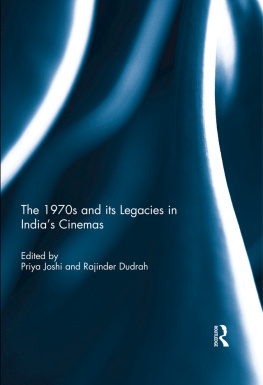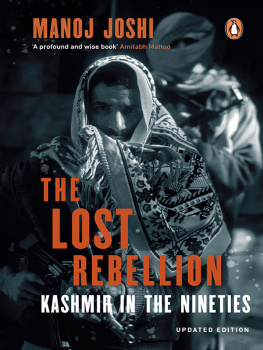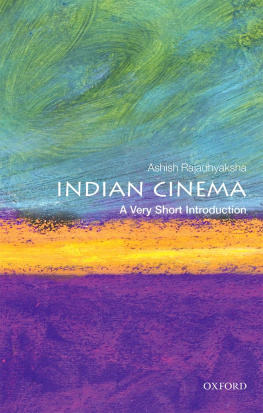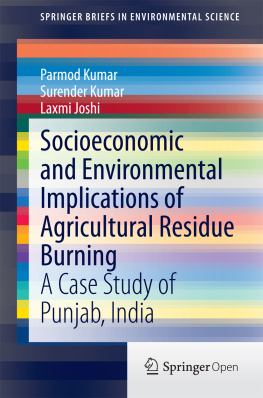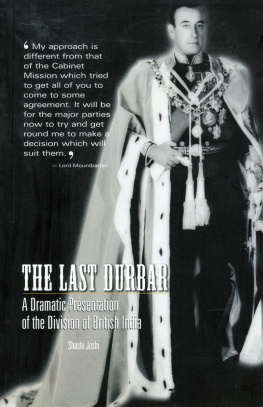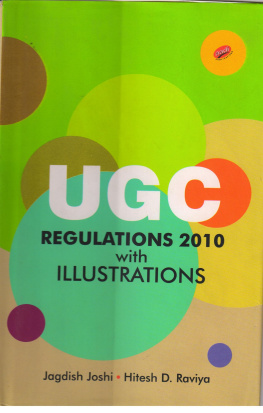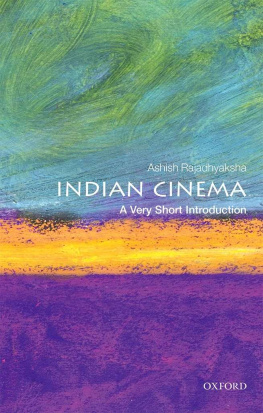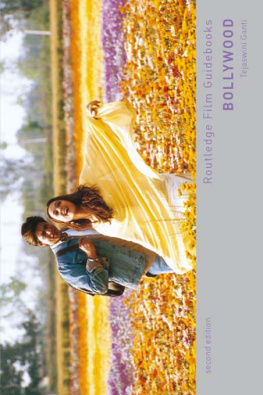BOLLYWOODS INDIA
BOLLYWOODS INDIA
A Public Fantasy
PRIYA JOSHI
Columbia University Press
New York

Columbia University Press
Publishers Since 1893
New York Chichester, West Sussex
cup.columbia.edu
Copyright 2015 Columbia University Press
All rights reserved
Library of Congress Cataloging-in-Publication Data
Joshi, Priya.
Bollywoods India : a public fantasy / Priya Joshi.
pages cm
Includes bibliographical references and index.
ISBN 978-0-231-16960-8 (cloth : alk. paper) ISBN 978-0-231-16961-5 (pbk : alk. paper) ISBN 978-0-231-53907-4 (ebook)
1. IndiaIn motion pictures. 2. Motion picturesIndiaHistory20th century. 3. Motion picturesUnited StatesHistory20th century. I. Title
PN1993.5.I8J673 2015
791.43'0954dc23
2014042100
A Columbia University Press E-book.
CUP would be pleased to hear about your reading experience with this e-book at .
Cover design: Jordan Wannemacher
Cover image: Based on a publicity poster for Deewaar (1975)
References to websites (URLs) were accurate at the time of writing. Neither the author nor Columbia University Press is responsible for URLs that may have expired or changed since the manuscript was prepared.
The dedication on is from yes is a pleasant country. Copyright 1944, 1972, 1991 by the Trustees for the E. E. Cummings Trust, from Complete Poems: 19041962 by e. e. cummings, edited by George J. Firmage. Used by permission of Liveright Corporation.
The epigraphs on are from Talking Films: Conversations on Hindi Cinema with Javed Akhtar, as recorded by Nasreen Munni Kabir (New Delhi: Oxford UP, 1999), 35; and from Sudhir Kakar, Intimate Relations: Exploring Indian Sexuality (New Delhi: Penguin, 1988), 27.
For Orfeo
love is a deeper season
than reason;
my sweet one
(and aprils where were)
There is one more state in this country, and that is Hindi cinema. And so Hindi cinema also has its own culture.... Hindi cinemas culture is quite different from Indian culture, but its not alien to us, we understand it.... As a matter of fact, Hindi cinema is our closest neighbor. It has its own world, its own traditions, its own symbols, its own expressions, its own language, and those who are familiar with it understand it.
JAVED AKHTAR
[Fantasy is] another name for that world of imagination which is fuelled by desire and which provides us with an alternative world where we can continue our longstanding quarrel with reality.... Fantasy is the mise-en-scne of desire, its dramatization in a visual form.
SUDHIR KAKAR
CONTENTS
ILLUSTRATIONS
TABLES
WRITING A BOOK ABOUT BOLLYWOOD is a bit like making a Bollywood film. Theres a substantial time lag between idea and execution. Editing takes forever. Producers are hard to find just when theyre most needed. And the starsthose ideas that glittered so enticingly in the dark screen of the mindbecome hard to pin down just as the schedule for completion nears. The only reason the book and the film are ever completed is the willing collaboration of many who throw themselves into the project in which they passionately believe.
It is an honor to name the many collaborators of this book. Thanks first to my students at Berkeley and Temple whose enthusiasm and indulgence shaped my thinking as the project developed. Students in a 2005 Berkeley Freshman Seminar insisted that I include blockbusters after liberalization in the book, and the chapter on Bollylite is a partial reply to them. Students at the Bryn Mawr Film Institute came to Bollywood after full careers and lives elsewhere and took unscripted delight in the form and its many pleasures.
This book would not be this book without the many intellectual and practical resources Temple University provided. Conversations at the New India Forum were invaluable in keeping contemporary India front and center. Special thanks to Richard Immerman and Peter Logan of the Center for the Humanities for bankrolling the Forum, and to Arvind Phatak and Kim Cahill for extending the largesse from a CIBER grant to pursue the lines of inquiry we did in those heady years. A 2011 workshop on the 1970s and its legacies in Indias cinemas focused many of the ideas that shape the present study. Thanks to the workshop participants, CIBER, and the College of Liberal Arts Research Council for making the event possible. Invitations to present portions of the argument at Brandeis, Bryn Mawr, Chicago, Harvard, Hawaii, Iowa, Madison, Old Dominion, and Penn provided lively occasions to sort out its claims.
Research in the humanities incurs considerable cost. Grateful thanks to the University of California, Berkeley, Washington University in St. Louis, Temple University, Temples Center for the Humanities, and the Penn Humanities Forum for enabling archival trips to India and supporting the writing time to complete this book.
The research staffs at the Library of Congress Film Research Division in Washington, D.C., and the British Film Institute in London were extremely accommodating. The National Film Archive of India in Pune provided unmatched courtesies during several visits. Special thanks to the director, Mr. Sheshadri, and the research staff: Kiran Diwar, Shubhalakshmi Iyer, Urmila Joshi, Arti Karkhanis, and above all the legendary P. K. Nair, who founded the archive and provided immensely useful oral histories of the Bombay film industry in the 1950s and 1970s. Temples Paley Library cheerfully acquired every obscure source requested, and its circulation staff took it upon themselves to flag and hold titles of potential interest for meunasked. Kristina DeVoes expertise made it possible to conduct research in the midst of full teaching terms: her clarifying questions frequently led to unanticipated areas of inquiry.
I was especially fortunate in my research assistants for sleuthing through the dense jungle of non-digitized sources and locating retrieval-resistant print materials: Daisy Duggan at Berkeley, Jason E. Cohen at Madison, Rich Gienopie and Daniel Ryan Morse at Temple were matchless in their genial partnership.
The community of scholars on Hindi cinema provided solidarity with this book and readily engaged its arguments by posing better ones of their own. The debt in the notes is one kind of payback. For the other kind are public thanks to many who are now personal friends as well: Ulka Anjaria, Kazi Ashraf, John Briley, Emma Bufton, Sumita Chakravarty, Sanjoy Chakravorty, Vikram Chandra, Gayatri Chatterjee, Anupama Chopra, Lawrence Cohen, Corey Creekmur, Kavita Daiya, Jigna Desai, Sara Dickey, Rajinder Dudrah, Rachel Dwyer, David Farris, Tejaswini Ganti, Ajay Gehlawat, Monica Ghosh, Sangita Gopal, Nitin Govil, Priya Jaikumar, Madhu Jain, Abhijat Joshi, Suvir Kaul, Sudipta Kaviraj, Sunil Khilnani, David Ludden, Philip Lutgendorf, Purnima Mankekar, P. K. Nair, Ashis Nandy, Veena Talwar Oldenburg, Swarnavel Eswaran Pillai, Satish Poduval, Madhava Prasad, Amaneep Sandhu, Harleen Singh, Jyotika Virdi, and Amanda Weidman. Behroze Gandhy and Rosie Thomas graciously provided permission and image, respectively, of the 1985 election poster that appears in archive of the industry has greatly enabled my scholarship. Nasreens hospitality in London and her friendship since make her a fairy godmother to this project.
Hindi cinema is hydra-headed, and heartfelt thanks to those in the industry who spoke with me about the 1970s without insisting that theirs was the only account that mattered. Javed Akhtar was especially generous during his visit to Philadelphia and always made time for my questions about the industry. Shabana Azmi, Randhir Kapoor, Rishi Kapoor, Shashi Kapoor, the staff of RK Studios, Girish Karnad, Feroze Rangoonwalla, Ramesh Sippy, Rohan Sippy, and Sheena Sippy were extraordinarily forthcoming with their time and insights in Bombay, Chembur, Khar, and London.
Next page

